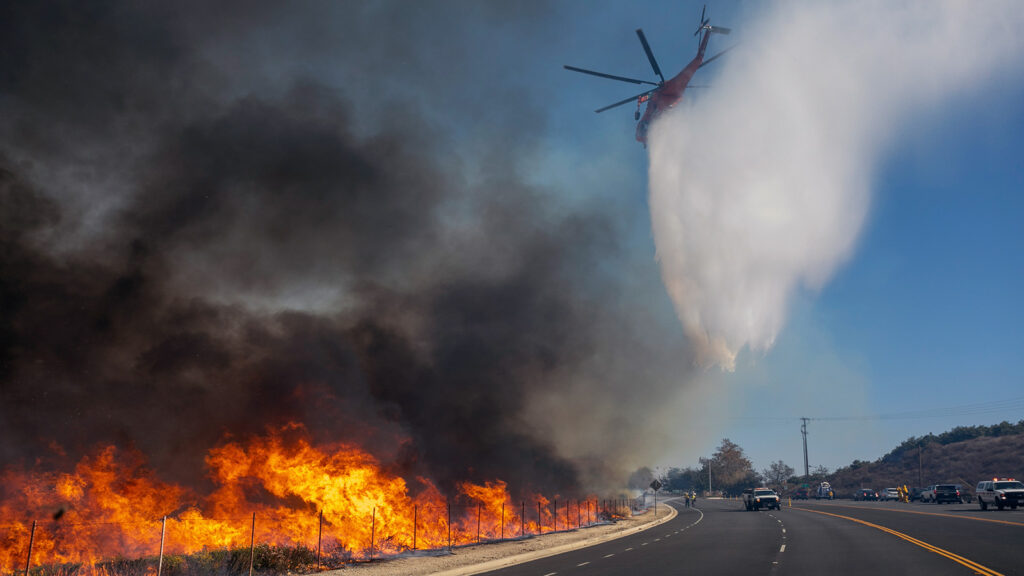NEWS
Santa Ana Winds The Unseen Force Behind California’s Wildfires
The St Nick Ana winds, a characteristic meteorological peculiarity extraordinary to southern California, have for some time been a characterizing element of the district’s environment. These dry, warm, and strong upper east breezes are famous for their part in energizing the absolute most disastrous rapidly spreading fires in the state’s set of experiences. Once more as California faces a rapidly spreading fire emergency, understanding the nature and effect of the St Nick Ana winds is basic to grasping the difficulties presented by this common danger.
The St Nick Ana twists begin from high-pressure frameworks that structure over the Incomparable Bowl, a far reaching desert locale crossing a few western states. These breezes start as chilly air masses caught in the high-elevation locales of the Incomparable Bowl. Affected by high air pressure, the air dives from the raised landscape and streams toward lower elevations in southern California. This plummet is a vital part of the breezes’ change. As the air moves descending, it packs, warms up, and loses its dampness, turning out to be incredibly dry and warm when it arrives at the seaside regions.
The breezes follow a way directed by the scene, traveling through the mountain goes that different the desert inside from the thickly populated beach front locales. These mountains go about as regular obstructions, and the air is compelled to just barely get through slender passes and gulches, a cycle that speeds up its speed. When the breezes arise on the opposite side, they are moving with enormous power, frequently arriving at velocities of 50 to 70 miles each hour and, at times, surpassing 100 miles each hour. This quick, dry wind stream essentially hoists the fire risk across the district.
The most hazardous part of the St Nick Ana twists lies in their capacity to make the best circumstances for out of control fires to light and spread. The dry air going with the breezes diminishes moistness levels to single digits, leaving vegetation — both living and dead — incredibly dry and profoundly combustible. This parching of plant material transforms the regular scene into an immense supply of fuel, prepared to light with the littlest flash. A brought down power line, an inappropriately quenched open air fire, or even a deviant cigarette butt can act as a start source. When a fire starts, the breezes go about as a roars, heightening the blazes and driving them across huge distances at disturbing rates.
The breezes’ capacity to ship coals over significant distances further intensifies their disastrous potential. These coals can light recognize fires miles from the primary burst, overpowering firefighting endeavors and jeopardizing lives and property in regions recently remembered to be protected. The blend of low mugginess, dry vegetation, and strong breezes has generally connected the St Nick Anas to a portion of California’s most destroying out of control fires.
One prominent model is the Woolsey Fire of November 2018. Energized by St Nick Ana winds, this rapidly spreading fire tore through southern California, asserting three lives and annihilating north of 1,600 designs. Another shocking occasion was the Franklin Fire, which harmed almost 50 homes in the Malibu region. These calamities highlight the enormous power and risk related with these breezes.
The name “St Nick Ana winds” is accepted to have begun from the St Nick Ana Gorge in Orange Province, through which these blasts frequently blow with specific power. Nonetheless, elective speculations about the name endure, including one that attaches the breezes to the Spanish expression “santanas,” signifying “fiend twists.” No matter what the beginning of their name, the breezes have become inseparable from the fierce blaze season in California, procuring a standing as one of the state’s most impressive regular powers.
While the St Nick Ana winds are a characteristic event, their effect on rapidly spreading fires has been exacerbated by human movement and the continuous impacts of environmental change. Electrical cables, a typical wellspring of start during wind occasions, have been at the focal point of warmed banters over fire moderation systems. Utilities have progressively turned to preplanned power shutoffs during high-wind conditions to forestall fires, an action that has started debate because of its problematic impacts on inhabitants and organizations.
Environmental change adds one more layer of intricacy to the issue. Increasing worldwide temperatures and delayed dry spells have left California’s vegetation more vulnerable to consuming, intensifying the peril presented by the breezes. Specialists caution that as environment designs keep on moving, the recurrence, power, and term of the St Nick Ana winds may likewise change, possibly expanding the out of control fire risk from here on out.
Endeavors to moderate the effect of the St Nick Ana winds and the fierce blazes they fuel incorporate superior land the executives rehearses, stricter guidelines ablaze inclined exercises, and progressions in fire discovery and concealment advances. Public mindfulness crusades have likewise underlined the significance of individual obligation, encouraging inhabitants to keep up with solid space around their properties, get ready crisis plans, and regard clearing orders during fire occasions.
The St Nick Ana winds are an obvious sign of the fragile harmony among people and nature in districts inclined to outrageous climate occasions. While they are a vital piece of southern California’s environment, their job in filling rapidly spreading fires features the requirement for cautiousness and proactive measures to safeguard lives, property, and regular assets. As the state keeps on adjusting to the difficulties presented by these breezes and the more extensive impacts of environmental change, coordinated effort among networks, legislatures, and specialists will be fundamental in building versatility and limiting the overwhelming effect of rapidly spreading fires. In this continuous fight against nature’s powers, understanding the St Nick Ana winds and their suggestions is an imperative move toward guaranteeing the security and maintainability of southern California.